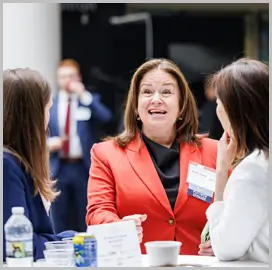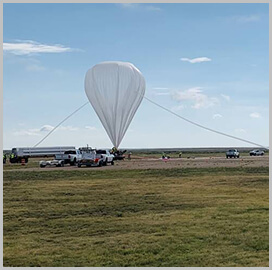
Register today for
the 2024 Cyber Summit!
Breaking Down the 2024 CIO Summit Panels
Potomac Officers Club’s 2024 CIO Summit was a rousing success, bringing together IT experts from across the GovCon landscape on April 17 to share ideas and hear about missions and the technologies that power them. Top government chief information officers discussed pressing and complex IT challenges with notable private sector leaders.
Below you’ll find key moments worth remembering from the day’s panel sessions. We also recently took a look at the day’s keynote speeches.
Looking ahead, you don’t want to miss POC’s next big event: the 2024 Cyber Summit. Join the conversation about digitally protecting American data with top government leaders on June 6 at the Ritz Carlton, Pentagon City.
Panel: “Generative AI: Enabling Transformation and Decision Making With Trusted Data”
Participants: Timothy McKinnon (Intelligence Advanced Research Projects Activity), Col. Michael Medgyessy (U.S. Department of the Air Force), Sean Williams (AutogenAI) and moderator Kevin Talbert (Cloudera Government Solutions)
Primary takeaways:
- Williams: Want to apply human notions of ‘trusted sources’ to LLM use
- McKinnon: Human-in-the-loop important to maintaining accuracy of AI results
- McKinnon: Models can be creative with inferences; what we need is a taxonomy of all ways inferences can be good or bad.
- McKinnon: Understanding of bias is complicated because sources available to LLMs are often biased.
- Organizations should “try to understand bias and use it to induce a set of diverse perspectives and play off of the analyst’s creativity.”
- Williams: AutogenAI uses air-gapped small language models to redact sensitive information
- Medgyessy: Intelligence data has been tagged more than any other data type, which gives opportunity to create good & well-informed models
- GovCon Wire coverage
Panel: “Enabling IT Modernization With GenAI”
Participants: Sonny Bhagowalia (U.S. Customs and Border Protection), Michael Chappell (Army PEO Enterprise Information Systems), Sujit Mohanty (Databricks) and moderator Robert McNamara (Guidehouse)
Primary takeaways:
- Bhagowalia: genAI use case = helping to detect fentanyl in shipments
- Bhagowalia: Language translation another promising AI use case
- Bhagowalia: 100 million cyber attack attempts per day on CBP’s network
- Bhagowalia: Hallucination rates need to be lower on AI for gov to take it seriously as decision support
- Mohanty: 3 areas Databricks does business on macro level:
- Data management analytics (notes how genAI can play a role)
- Cybersecurity
- Data warehousing on the whole
- Chappell: When I dream about genAI, looking at models as employees, need an AI resource [aka HR] department
- “I would love to get AI to care about its ‘children’ and progeny as new models get developed from old models over time”
- Chappell: Checks and balances system needed for AI
- GovCon Wire coverage
Fireside Chat: “Enabling Choice, Flexibility and Resilience to Ensure Government Mission Success”
Participants: Jennifer Swanson (U.S. Army) and moderator Tricia Fitzmaurice (Rancher Government Solutions)
Primary takeaways:
- Swanson’s office (Deputy Assistant Secretary of the Army for Data, Engineering & Software) leveraging of new acquisition tools from DOD, including MTAs
- Revamped ability to acquire & deliver
- Gone are the days it took 10 years to field acquire and deliver
- Security with AI a big consideration for military use
- Army Secretary Christine Wormuth spoke at South-by-Southwest this year and highlighted importance of software
- Fitzmaurice says you think Army, you think hardware, but Swanson says all of that hardware is software-driven today
- Swanson is the first DASA(DES)
- Army’s unified data reference architecture, or UDRA, is new concept even for industry
- UDRA timeline:
- 3-4 month sprints with industry for UDRA
- Industry days
- First RFI — responses tried to sell them diff solutions and they weren’t there yet
- Currently on UDRA 1.0
- Swanson: Open architectures are critical, going back to Wormuth’s SX comments, need to link it back to software. Architecture needs to be cleanly designed
Panel: “Navigating the IT Modernization Journey: Insights from Leaders Shaping the Future”
Participants: Kaschit Pandya (IRS), Laura Williams (U.S. Department of State), Jamie Wolff (Department of Energy), Amanda Bullock (Air Force Research Laboratory) and moderator Eric Lazerson (Acuity)
Primary takeaways:
- Williams: State Department’s IT modernization focus = customer-centric
- Wolff: DOE = focused on outcomes rather than strategy
- IT infrastructure across disparate organizations + connecting to commercial cloud
- Implementation from a logistics perspective
- Pandya: Embracing low-code software requires major cultural change
- Was a big shift for IRS to let go of some traditional IT
- Wolff: DOE wants tech to be responsive to the workforce + user
- They already have information, taking action = the problem
- Williams: There is a knowledge management problem and a digital detritus problem with abandonment rate of apps.
- “What happens when that officer or even that IT professional rotates out and goes to the next place?”
- Pandya: Incorporating a shift in responsibilities going forward – a lot more program managers than technologists
- GovCon Wire coverage
Panel: “Strengthen Mission Success: Navigating Multicloud Strategies”
Participants: Roger Greenwell (Defense Information Systems Agency), Darek Kitlinksi (U.S. Army) and moderator Mark Andress (Oracle Government Defense and Intelligence)
Primary takeaways:
- Greenwell: DISA recently awarded an OTA for distributed hybrid cloud model to HP.
- Greenwell: DOD “must maintain a hybrid [cloud] model”
- “How do we modernize both our on-prem capabilities, leveraging more in a hybrid way, but realizing that we have to have that maneuverability back and forth between on-prem, cloud and in the commercial spaces? And at all classifications.”
- Kitlinski: Army instituting new cloud procedures and policies, which is highly necessary because of amount of adoption needed
- Kitlinski: Army taking new approach to cloud work, requiring more up-front expertise and existing relationships with vendors + CSPs
- Kitlinski: In order to do AI/ML properly, you need enterprise cloud.
- GovCon Wire coverage

Category: Speaker News




